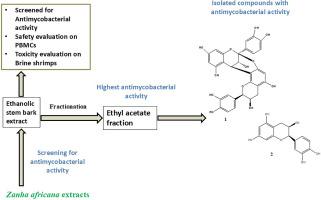Zanha africana (Radlk.) Exell 的治疗潜力:抗霉菌活性和安全性评估
IF 2.7
Q2 MULTIDISCIPLINARY SCIENCES
引用次数: 0
摘要
背景Zanha africana (Radlk.) Exell 的提取物在坦桑尼亚和其他国家通常用于治疗与艾滋病毒和艾滋病有关的疾病,包括肺结核(TB)。在坦桑尼亚,它被列为不同市场上交易最频繁的药用植物品种之一。本研究旨在评估非洲杉乙醇提取物的安全性和抗霉菌活性。方法采用肉汤微稀释法评估了粗提取物对各种非致病分枝杆菌菌株(包括金黄分枝杆菌(MA)、马达加斯加分枝杆菌(MM)和indicus pranii分枝杆菌(MIP))的抗分枝杆菌活性。采用生物测定指导分馏法分离出活性化合物。通过外周血单核细胞(PBMCs)细胞毒性试验和盐水虾致死试验研究了粗提取物的安全性。茎皮乙醇提取物对 MA、MM 和 MIP 的抗霉菌活性分别为 625 µg/mL、313 µg/mL 和 125 µg/mL。乙酸乙酯萃取物是最有效的萃取物,从中分离出两种活性化合物:原花青素 A2;化合物 (1) 及其单体表儿茶素,化合物 (2)。与化合物(2)相比,化合物(1)表现出更高的抗霉菌活性,对 MM 和 MIP 的最低抑制浓度(MICs)分别为 19.50 µg/mL 和 12.98 µg/mL。乙醇提取物对 PBMCs 和盐水虾没有毒性。这为传统上使用非洲杉提取物治疗结核病提供了证据支持。建议开展进一步研究,利用不同模型全面评估植物成分的有效性和安全性。本文章由计算机程序翻译,如有差异,请以英文原文为准。

Therapeutic potential of Zanha africana (Radlk.) Exell: antimycobacterial activity and safety evaluation
Background
Zanha africana (Radlk.) Exell extracts are commonly utilized in Tanzania and other countries for treating conditions associated with HIV and AIDS, including tuberculosis (TB). In Tanzania, it is listed among the most frequently traded plant species for medicinal use in different marketplaces. However, limited literature exists regarding its antimycobacterial properties and safety profile.
Objective
This study aimed to evaluate Z. africana ethanolic extract for safety and antimycobacterial activity.
Methods
The antimycobacterial activity of the crude extracts was assessed using the broth microdilution method against various non-pathogenic mycobacteria strains including Mycobacterium aurum (MA), Mycobacterium madagascariense (MM), and Mycobacterium indicus pranii (MIP). Bioassay-guided fractionation was employed to isolate the active compounds. The safety profile of the crude extract was investigated through cytotoxicity assay on peripheral blood mononuclear cells (PBMCs) and the brine shrimp lethality test.
Results
The 80% ethanolic extracts of Z. africana demonstrated activity against all tested non-pathogenic mycobacteria. The antimycobacterial activity of ethanolic extract of the stem bark was 625 µg/mL, 313 µg/mL and 125 µg/mL against MA, MM, and MIP, respectively. The most potent fraction was the ethyl acetate fraction, from which two active compounds were isolated: proanthocyanidin A2; Compound (1) and its monomer epicatechin, Compound (2). Compound (1) exhibited higher antimycobacterial activity compared to compound (2) with minimum inhibitory concentrations (MICs) of 19.50 µg/mL and 12.98 µg/mL against MM and MIP respectively. The ethanolic extract did not demonstrate toxicity on PBMCs and brine shrimps.
Conclusion
This study demonstrates that Z. africana extracts and the isolated compounds possess antimycobacterial activity. This provides evidence supporting the traditional use of Z. africana extracts for TB management. Further research is recommended to comprehensively evaluate the efficacy and safety of the plant constituents using different models.
求助全文
通过发布文献求助,成功后即可免费获取论文全文。
去求助
来源期刊

Scientific African
Multidisciplinary-Multidisciplinary
CiteScore
5.60
自引率
3.40%
发文量
332
审稿时长
10 weeks
 求助内容:
求助内容: 应助结果提醒方式:
应助结果提醒方式:


